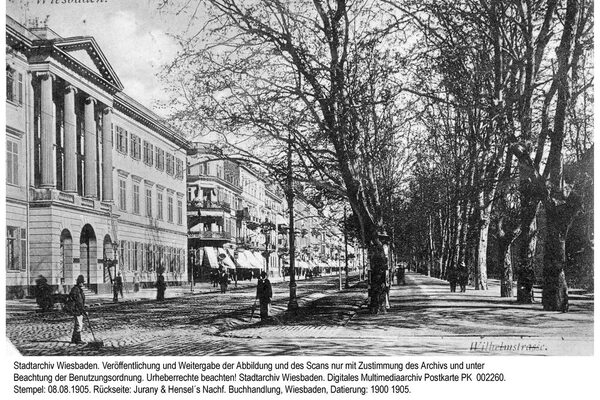Chamber of Industry and Commerce (IHK)
The Nassau chambers of industry were established in accordance with the law of September 3, 1863 on the establishment of chambers of commerce and were intended to promote trade and commerce. An implementing decree of 1864 divided the Duchy of Nassau into three chamber districts and designated Dillenburg, Limburg and Wiesbaden as their seats. The district of the Wiesbaden Chamber of Commerce (HK) comprised the offices of Idstein, Usingen, Reichelsheim, Königstein, Höchst am Main, Hochheim, Wiesbaden, Eltville, Rüdesheim, St. Goarshausen, Nastätten, Langenschwalbach and Wehen. All merchants who operated a business entered in the commercial register on their own account or as personally liable partners were liable to pay contributions and entitled to vote. In Wiesbaden, this included 276 sole traders and 34 companies. All eligible voters elected a total of 18 members for a term of office of six years according to a democratic election system - whereby women (until 1920) did not have the right to vote and had to be represented by a proxy if necessary - half of whom were eliminated by lot after three years, but could be re-elected. Following a formal error in the first election, the eligible voters from the city and district of Wiesbaden came together a second time on October 3, 1864 to elect the eight members who were to represent them. Because the Nassau government successfully contested the election of the liberal politician Karl Braun, the constituent meeting of the HK Wiesbaden could only take place on February 11, 1865. Rüdesheim wine merchant Theodor Dilthey was elected chairman and Wiesbaden merchant Karl Glaser was elected deputy chairman. Dilthey was followed by the leather manufacturer Carl August Lotichius from St. Goarshausen (1867-82), Rudolf Koepp, founder of the Koepp Chemical Factory in Oestrich (1888-97) and Franz Fehr-Flach, owner of the Wiesbaden tin foil and metal capsule factory (1897-1920), who held the title of "President" from 1917.
For a long time, the HK Wiesbaden had neither its own business premises nor full-time staff. The tasks were divided among the members. A chamber secretary acted as secretary. His home was also the Chamber office. For decades, meetings were held in the town hall or in various restaurants in Wiesbaden. With the Prussian law on chambers of commerce from February 24, 1870, the HK also received a new legal basis. Little changed in terms of tasks and responsibilities. After the introduction of the Prussian district constitution in 1890, the Chamber of Commerce district comprised the city and district of Wiesbaden, the district of Höchst, the district of Usingen, the Untertaunuskreis, the Rheingaukreis and the district of St. Goarshausen (without the former Amt Braubach). In 1873, Julius Oppermann from Diez became the first secretary who did not come from the circle of members. His successor Wilhelm Flindt, also from Diez, bore the title "Syndic" from 1888, and his successor, Dr. Reinhold Merbot (1891-1916), was the first full-time chamber syndic. Under his management, the Chamber of Commerce acquired the building at Adelheidstrasse 23 in 1904 and thus had its own business premises for the first time. The increasing importance of the industrial sector was taken into account in 1924 when the Chamber of Commerce was renamed the "Chamber of Industry and Commerce" (IHK). In 1928, it had to cede the towns of Höchst, Nied and Griesheim, which had been incorporated into Frankfurt am Main, to the Frankfurt Chamber of Industry.
After the National Socialist seizure of power, the Prussian Chamber of Industry and Commerce for the Rhine-Main region was founded in Frankfurt by decree of the Prussian Minister of Economics and Transport on April 24, 1933. The IHK Wiesbaden formally lost its independence, but remained largely autonomous as a district office. The executive committee and members resigned in April 1933. Even the Jewish members and those known for their democratic views no longer belonged to the new body. From then on, the Führerprinzip applied: Dr. Carl Lüer, as President of the IHK for the Rhine-Main economic area, appointed the presidents of the district offices, who in turn appointed their deputies. In this way, the IHK was brought into line and the National Socialists were able to use it for their own purposes, for example in the so-called Aryanization of Jewish assets or the distribution of foreign forced labourers.
On 01.01.1943, the chambers of industry and commerce were dissolved and merged with other economic organizations to form Gauwirtschaftskammern. In April 1945, a few weeks after the occupation of Wiesbaden, the IHK was re-established. The American military government appointed Dr.-Ing. August Amann, Chemische Werke Albert AG, as president and Erich Köhler as managing director. Köhler, who switched to politics, was succeeded in 1949 by Dr. Wolfgang Weynen. As a result of the occupation borders, the IHK Wiesbaden lost the district of St. Goarshausen to the IHK Koblenz, but was assigned the former Mainz districts of Amöneburg, Kastel and Kostheim. Although the Hessian chambers of industry and commerce played an important role in the reconstruction, they initially lost their status under public law following an order by the Americans. It was not until the Act on the Provisional Regulation of the Law of Chambers of Industry and Commerce of December 18, 1956 (Hessian Implementation Act of November 6, 1957) that they regained their former legal status. Since then, membership has been compulsory for all commercial, service and industrial companies in the chamber district. In 1968, the IHK acquired the Erbprinzenpalais, built by Christian Zais, from the city, where it still has its headquarters today. Today (2016), the IHK Wiesbaden looks after around 38,000 member companies.
Literature
Geisthardt, Fritz: Wiesbaden and its merchants, Wiesbaden/Stuttgart 1980 (Chamber of Industry and Commerce publication series 1).
Ten decades of contemporary events in the mirror of old minutes. Special edition of Hessische Wirtschaft, 11.02.1965.
